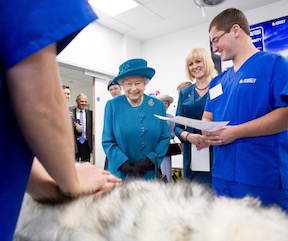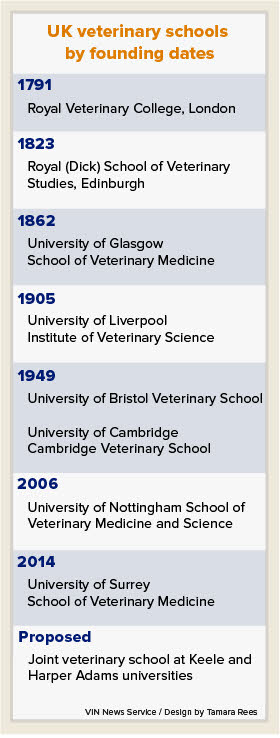queen at surrey

University of Surrey photo
Queen Elizabeth II toured the University of Surrey School of Veterinary Medicine for its grand opening in 2015. The U.K.'s eighth veterinary school, Surrey enrolled its first students in 2014 and opened new facilities the following year. Plans for a ninth school are in the works.
The last time the United Kingdom marked the opening of a new veterinary college, in 2015 at the University of Surrey, Queen Elizabeth II was on hand for the festivities. Her Majesty's presence underscored the significance of the occasion: Just one other British school, in Nottingham, had opened in 65 years.
Behind the regalia, many people in the local veterinary community weren't celebrating. They feared an increase in the number of new graduates could create an oversupply of veterinarians, dampening pay and working conditions.
The U.K. voted the following year to leave the European Union. The decision sparked a contrasting concern about a potential undersupply of veterinarians, should thousands of expatriate workers leave. Even still, plans for yet another veterinary school in Britain are stirring a fresh bout of controversy.
The proposed new college is a joint effort between Keele University and Harper Adams University, located in the communities of Staffordshire and Shropshire, respectively, about 165 miles northwest of London in England's rural heartland.
Last July, the universities formalized their interest in developing the school in a memorandum of understanding, an early-stage and non-binding agreement. Details on when it would open and what it would look like are few, and progress appears to be slow. Another public announcement by the pair, due before the end of 2017, didn't materialize. Contacted by the VIN News Service in January, university representatives declined to comment, referring instead to statements from Keele and Harper Adams posted months earlier.
Dr. Stephen May, president of the Royal College of Veterinary Surgeons (RCVS), the profession’s regulatory body, said concerns in the community about workforce size are ongoing, but the situation is dynamic. "There's always been an interest in whether new schools might saturate the market, but the reality is that for years, we have required veterinary graduates from outside the U.K. to meet demand," he said. "At the moment, we're just about matching demand. Another vet school coming in could potentially tip that over, although perhaps not quite, because in various parts of the country, there is some difficulty recruiting."
May stressed that foreign veterinarians might start avoiding the U.K. if they believe there is an oversupply, balancing out the situation. Then, of course, there's Britain's exit from the European Union, known as Brexit. Nobody knows exactly how talks will pan out between European and British officials as they negotiate the details of withdrawal, scheduled to be completed by March 2019. EU nationals currently account for about a quarter of Britain's 5,000 veterinary surgeons.
Should those immigrants depart en masse as a result of Brexit, May said, "Then, even with [the addition of] Surrey and even one other school — and even with the expansion in numbers at the existing schools — on all the figures and predictions, there would be a [workforce] shortfall."
Worked 'like a dog'
Recent graduates of existing U.K. veterinary schools describe prevailing poor workplace conditions even as practices struggle to fill vacancies in the wake of the Brexit vote. And they're not sure that opening what would be the country's ninth veterinary college will help practices fill the gap.

Dr. Elliot Kneba, who graduated from the Royal Veterinary College in 2015, said the problem isn't a shortage of workers per se — rather, it's a shortage of workers willing to accept employment under difficult conditions.
For instance, he said, the U.K. could face a particularly large deficit of talent in the agricultural sector, which is something proponents of a new school appear to be trying to tackle. In Harper Adams’s July 20 statement, Vice Chancellor David Llewellyn is quoted as saying that the university “has a long and proud history of working with the rural sector,” with “teaching and research specialisms in agriculture and animal sciences ...”
But, Kneba said, "The problem isn't that there's not enough students. The problem is that nobody wants to do the work because it pays poorly, the hours are anti-social and it can be dangerous."
Kneba added: "It's a very similar misguided thought to what they have in the U.S.: 'Let's just open another vet school because there aren't enough vets.' "
Concerns about the supply and well-being of veterinarians are rife in the United States, where two new schools opened in 2014 and more are proposed. At the same time, most U.S. graduates are burdened with heavy student debt. In 2016, the average school debt of new graduates was between $144,000 and $168,000, depending on how the figure is calculated, and many owed upwards of $200,000, according to the American Veterinary Medical Association.
British veterinary students have a large chunk of their tuition subsidized by the government, although out-of-pocket costs have risen to around £9,000 (US $12,400) per year. Students may borrow from the government to cover that share. Such debts must be paid only after the graduate's income passes a certain threshold. Whatever remains is written off after 30 years, and the forgiven sum is not taxed.
Veterinarians in the U.K are, however, paid less than their American cousins, earning between £30,000 and £50,000 on average per year (US $41,000 to US $69,000), government figures show. That compares to the $88,770 median made by U.S. veterinarians, according to the U.S. Department of Labor.
U.K. veterinarians do better on vacation benefits. Full-time workers typically are entitled to 28 days of paid leave per year, whereas employees in the United States, which has no statutory requirements for paid vacation, tend to get between 5 and 10 days after a year of service, with paid leave usually rising over time.
While at work, though, conditions can be rough, new veterinarians in the U.K. report. "In my first job out of vet school, I made £26,000 a year, and I worked like a dog," said Dr. Jane Smith, who asked to use a pseudonym due to her employer's strict media policy.
Smith said she would alternate between a six- or seven-day week and a three-day week while putting in 12-hour shifts. "Every single second of our day was scheduled," she said. "Now we've clued in that we're being hugely taken advantage of, and we're kind of done."
Both Smith and Kneba have quit as general practitioners and are interning at colleges to attain a specialization. Smith said working as a locum, or relief veterinarian, also is seen by many of her colleagues as a more attractive option because the pay rates are higher.
Not all veterinarians, however, have the same level of concern about compensation.
"Although there are a lot of complaints about vets' salaries, I have never had to worry too much about money," said Dr. Kate Parkinson of East Anglia. "I earn more than my father did, and aspire to keep a roof over our heads, to travel and be happy."
Parkinson graduated in 2006. Her starting salary was about £18,000 to £20,000, she said. Her pay crept up to £34,000 when she worked for a corporate employer in 2011.
Parkinson spent about 10 years working as an employee in general practice. Now she earns about £60,000 a year, before taxes and expenses, working as a freelance locum. She’s still paying off student debt.
"Myself and colleagues have had many discussions about workforce size. The situation seems to be that there is no shortage of new graduates, but few are staying in the profession," Parkinson observed.
A perplexing question
Her account chimes with recent research showing practices are struggling to find experienced general practitioners, despite a steady flow of graduates coming onto the market. A survey conducted in September and October last year by the Society of Practising Veterinary Surgeons found that more than half of 238 respondents did not have a full complement of veterinary surgeons. Most had attempted to recruit a surgeon during the past 12 months, and fewer than one-quarter had found an employee within three months.
Their struggles raise a perplexing question: Why are pay and conditions for general practitioners still so low when practices are struggling to find veterinarians?
The answer, at least in part, could have something to do with the state of the economy more broadly. As in the U.S., unemployment levels have fallen to record lows in the U.K. as central banks held down interest rates to stimulate their economies following the global financial crisis that struck in 2008. Wages, however, have remained stubbornly stagnant.
"Practices have felt constrained by the income they've got and they've felt constrained in increasing their prices because of the low-inflation regime that we're sitting in," May said. "So they just haven't gone out in the market aggressively with salaries, though there's a little bit of evidence they're starting to go up."
That doesn't explain the pay discrepancy between veterinarians in the U.K. and U.S., however. On that issue, another important factor could be at play.
Attitudes on human health care differ significantly in the U.K. from the U.S., owing to the state-funded National Health Service, a great source of British national pride. U.S. citizens are responsible for taking care of their own medical expenses through private insurance and don't get the same level of taxpayer-funded support as British citizens.
That can create a misperception about the true cost of health care, even for animals.
"I think it colors the attitude to vet fees," said May. "We are a caring and altruistic profession, but balancing our support of the public and charging appropriately for our services at times has been challenging."
Average veterinarian fees in 2016 were around £300, with an initial consultation fee of around £35, according to Money Supermarket, a British price-comparison site.
May said the RCVS, in partnership with the British Veterinary Association, is in the early stages of a campaign designed to educate the public about the value of veterinarians and their expertise, while emphasizing that pet ownership is a privilege, not a right.
Meanwhile, Smith believes that the U.K. has a cultural problem when it comes to assessing the true value of veterinary services.
Veterinarians from the EU, she said, may be prepared to work for less. But if Brexit prompts them all to leave, the local industry could be forced to start offering local graduates a better deal.
"I think the U.K. will go through a culture shock, which will be better for everyone here," she said. "And I don't think a new vet school is going to make any difference to that."
Update: On May 15, Keele University and Harper Adams University announced confirmed plans to establish a new joint veterinary school. The school is anticipated to enroll its first students in 2020.